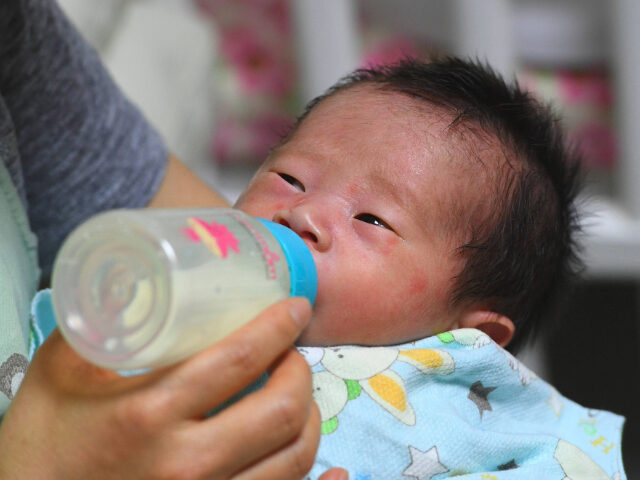South Korean President Yoon Suk-yeol declared a “demographic national emergency” on Wednesday and promised his government would take all possible measures to reverse the population decline.
“Today, I officially declare a demographic national emergency. We will activate a pan-government comprehensive response system until the low birth rate issue is overcome,” Yoon said, speaking from a childcare center south of Seoul.
South Korea’s Yonhap News summarized Yoon’s three-point plan for dealing with the demographic crisis: “balancing work and life, improving child care and providing better housing to address the complex issues.”
The details proved to be a mixture of policies that other countries suffering from severe population decline, such as China and Japan, have attempted:
The measures include increasing parental leave allowances and extending leave for fathers, aiming to raise the usage rate of paternity leave from the current 6.8 percent to 50 percent during Yoon’s term.
They also include implementing flexible work hours, extending the age limit for reduced working hours for parents of young children and providing subsidies for employers who hire temporary replacements for employees on parental leave.
Yoon also vowed to increase support for child care and expand after-school programs at elementary schools to ease the educational burden on parents.
Yoon said a “Ministry of Population Strategy Planning” would be created to oversee his program, which a “deputy prime minister for social affairs” would preside over. The South Korean legislature still must approve his program before it can be implemented.
Most industrialized Asian nations are grappling with population decline, but South Korea currently has the lowest birth rate in the world, and it is expected to fall even further by 2026. In December 2023, the government statistics bureau projected that the current birth rate of 0.78 per woman will sink to 0.65 by 2025 and could be down to 0.59 by 2026.
Statistics Korea offered a faint note of optimism by projecting that birth rates would rise back up to 1.08 per woman by 2072, but that is a very thin hope on a very long timetable, and it would still be far below the 2.1 rate needed for a stable population.
Western industrialized nations have serious demographic problems, too, including the United States, where the birth rate is a dismaying 1.66 per woman but trending up slightly. Unlike Asian nations, Western countries cover their declining birth rates with massive levels of immigration, legal and otherwise.
The worst of the fading Asian nations — South Korea, Japan, and China — have almost no immigration. Japanese Prime Minister Kishida Fumio’s Population Strategy Panel suggested in January that more high-skilled foreign workers should be allowed into the country to offset the effects of population decline, but even that suggestion was geared toward picking up the slack from a generation of Japanese workers that was never born, not shoring up Japan’s demographics with permanent immigrants.
Throwing money at the factors commonly cited for low birth rates, such as high child care and housing costs, does not seem to help as much as government planners hoped. South Korea, for example, has already spent almost $300 billion on subsidies for marriage, childbirth, child care, discounted mortgage rates, and extended family leave, without noticeable effect. Japan and China have seen few gains from similar initiatives.
High costs of living and glum economic prospects appear to be significant factors in population decline, but the more serious problem — and one that seems very difficult for government policies to address — is that young people in wealthy industrialized nations simply are not interested in marrying young and having children.
Young people in both Asia and the West are placing higher priorities on completing higher education, developing their careers, and pursuing their hobbies and interests. The opportunity cost of having children in their youth is simply too high, even with heavy subsidies for rent and child care. By the time people feel completely secure in their careers and finances, it is too late for them to begin raising the large families needed to achieve net population growth.
In Asian countries, the effect of this phenomenon on birth rates is even more pronounced than in the West because Asian cultures tend to have stronger stigmas against children born out of wedlock. Until recently, illegitimate children were often denied access to benefits that would be available to a married couple. Fewer than three percent of children in South Korea are born outside of marriage.
South Korea’s statistics agency reported in March that marriage rates declined by 40 percent over the past ten years, offset only by a tiny statistical blip in 2023 from weddings that were delayed by the Wuhan coronavirus pandemic.
The study found less than one-third of young South Koreans had a positive view of marriage, a stunning drop from the 56 percent approval rate recorded in 2012. Marriage rates were down across the board, but they fell even more for South Koreans under 30 years of age.
Even more severe was the drop in second and subsequent births, which fell by 40 percent in half a decade and dropped below 100,000 for the entire country for the first time in 2023. This is consistent with marriage dwindling among South Koreans in their twenties.

COMMENTS
Please let us know if you're having issues with commenting.